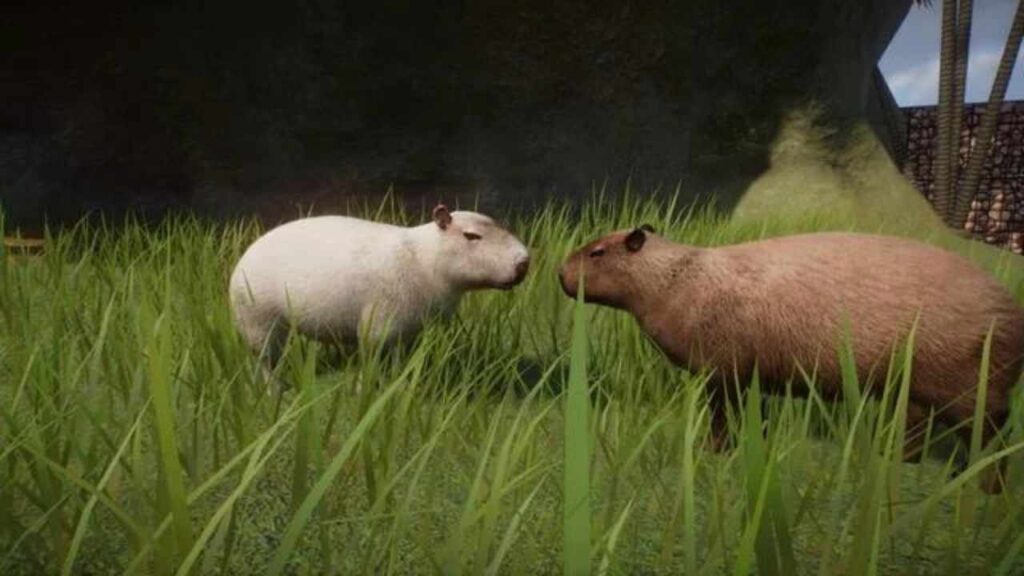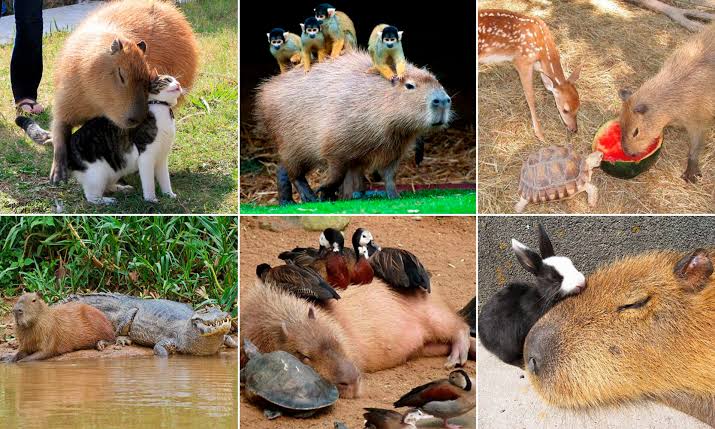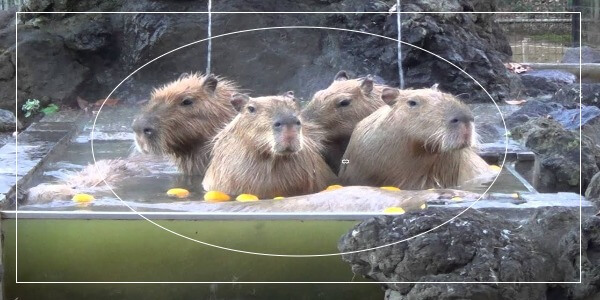When it comes to the gentle giants of the animal kingdom, capybaras often steal the spotlight. These remarkable creatures, resembling oversized guinea pigs, capture our hearts with their endearing appearance and gentle demeanor. However, despite their seemingly docile nature, capybaras reside in a world where the law of survival prevails.
The question often arises in discussions about capybaras is whether these amiable herbivores fall prey to any animals in their natural habitats
Do Capybaras Have Predators?
Yes, capybaras have predators in their natural habitat. Being herbivorous and the largest rodents in the world, capybaras are targeted by various predators. Some of their main predators include jaguars, caimans, anacondas, pumas, and large birds of prey.
These predators take advantage of the capybaras’ size and herbivorous nature. Capybaras are often found near water bodies, which makes them vulnerable to predation by caimans and anacondas.
What are the Main Predators of Capybaras in Their Natural Habitat?
While capybaras possess an impressive stature, reaching up to four feet in length and weighing as much as an adult human, they are not invulnerable to the forces of nature.
- Jaguars (Panthera onca): One of the most iconic and powerful predators in the Americas, jaguars are known to hunt capybaras. With their stealth and agility, jaguars ambush capybaras that come near the water’s edge. Their powerful jaws and sharp teeth enable them to deliver a swift and fatal bite, making capybaras vulnerable to these apex predators.
- Caimans (Caiman sp.): As semi-aquatic reptiles, caimans are natural predators of capybaras due to their shared habitat in wetlands and rivers. Caimans stealthily wait underwater, patiently observing their surroundings for potential prey. Capybaras that venture too close to the water become easy targets for caimans, which employ a sudden burst of speed to snatch their unsuspecting prey and drag them underwater.
- Anacondas (Eunectes sp.): The mighty anacondas, the largest snakes in the world, also threaten capybaras. These constrictors rely on their immense size and strength to overpower their prey. While capybaras are generally too large for an anaconda to swallow whole, they can still be suffocated or injured by the snake’s powerful coils.
- Pumas (Puma concolor): These large felines can be formidable predators in regions where capybaras and pumas share territories. Pumas are solitary hunters known for their stealth and ambush tactics. Although capybaras can be challenging prey for pumas due to their size, juveniles, injured, or weakened individuals may become targets.
- Birds of Prey: Several large bird species are known to prey upon capybaras. Harpy eagles (Harpia harpyja) and black vultures (Coragyps atratus) are among the avian predators that can target smaller or more vulnerable capybaras. These aerial hunters swoop down from the sky, using their sharp talons or beaks to seize prey.
- Other Threats: While not direct predators, other threats indirectly affect capybara populations. These include large predatory fish like piranhas, which can injure capybaras when they enter the water, and domestic dogs, particularly in areas where human settlements encroach upon capybara habitats.
Why Are Capybaras So Friendly?
Where Can I Buy a Capybara Near Me? – [Recommended]
Do Capybaras Have any Defense Mechanisms to Protect Themselves from Predators?

Capybaras employ several defense mechanisms to protect themselves from predators. While they are not known for being aggressive, they have developed various adaptations to increase their chances of survival. First and foremost, capybaras rely on their keen senses to detect potential threats. With their excellent hearing and sharp eyesight, they can quickly spot predators and take necessary action.
One of their primary defense strategies is their social nature. Capybaras live in large groups, forming herds that provide safety in numbers. When faced with a predator, capybaras exhibit a cooperative defense mechanism. They emit loud alarm calls, alerting others in the herd to the danger. This vocal communication helps coordinate their responses and increases the chances of survival for the group.
Additionally, capybaras are strong swimmers and take refuge in water bodies when pursued by predators. They can swiftly dive underwater, submerging for several minutes to evade capture. Their webbed feet and streamlined bodies aid in their aquatic escape.
Capybaras also possess a specialized gland on their nose called the Morillo. This gland secretes a pungent odor, which acts as a deterrent to some predators. The scent may signal that the capybara knows the predator’s presence and is prepared to defend itself.
How Long Do Capybaras Live In Captivity?
How Do Capybaras Survive in the Amazon Rainforest?
How Does Predation Impact Capybara Populations in the Wild?
Predation plays a significant role in shaping capybara populations in the wild. The impact of predation on capybaras can be both direct and indirect, influencing their abundance, distribution, and behavior. Predators such as jaguars, caimans, anacondas, pumas, and large birds of prey threaten capybaras.
Directly, predation can result in the loss of individual capybaras. When capybaras fall victim to predators, it can lead to a decrease in their population size. This is particularly true for vulnerable individuals such as juveniles, sick or injured individuals, or those in compromised situations. The frequency of predation incidents and the predation pressure exerted by different predator species can influence the overall mortality rate among capybaras.
Indirectly, the fear of predation can impact the behavior and distribution of capybaras. They may adopt various strategies to minimize predation risk, such as living in groups, utilizing open areas with good visibility, or relying on their excellent swimming abilities to escape predators. These behavioral adaptations can influence the habitat use and social dynamics of capybaras.
Additionally, predation can create a cascading effect on the ecosystem. Predators can influence capybaras’ spatial distribution and behavior, affecting vegetation, grazing patterns, and nutrient cycling. This interplay between predation, capybara populations, and their environment highlights the complex ecological relationships within their ecosystems.
What is the Typical Hunting Behavior of Capybara Predators?
The typical hunting behavior of capybara predators varies depending on the species, but they generally exhibit certain common strategies. As large rodents, Capybaras are preyed upon by various predators, including jaguars, caimans, anacondas, pumas, and birds of prey.
Jaguars, being skilled hunters, often employ stealth and ambush tactics to capture capybaras. They rely on their powerful jaws and sharp claws to deliver a swift and lethal attack. Similarly, pumas may stalk and ambush capybaras, using their agility and strength to overpower them.
Caimans, anacondas, and other reptilian predators typically target capybaras when they are in or near water. They utilize their aquatic abilities to surprise and seize the capybaras, employing techniques like biting, constricting, or drowning their prey.
Birds of prey, such as large raptors, primarily hunt young or vulnerable capybaras. They use their exceptional vision and aerial prowess to locate and swoop down on their prey, snatching them with their talons.
Reasons Capybaras Like To Live Near Rivers (Obsessed With Water?)
What Capybaras Need To Survive Any Where
Conclusion
The largest rodents in the world do have predators in their natural habitats. These fascinating creatures, known for their friendly and social nature, are not exempt from the realities of the animal kingdom. Various animals, including jaguars, caimans, anacondas, pumas, and large birds of prey, threaten capybaras.
While capybaras may seem peaceful and defenseless, they have certain adaptations to help them navigate their predator-filled environment. Their keen awareness and agility enable them to detect potential threats and quickly escape when necessary. However, they primarily rely on their strength in numbers and social structure for protection, using communal vigilance as a powerful defense strategy.


![Why Do Capybaras Not Have Tails? - [Answered] Why Do Capybaras Not Have Tails](https://capybaratips.com/wp-content/uploads/2023/03/Capy-Tail-250x200.webp)


![How Long Do Capybaras Live? - [Answered] How Long Do Capybaras Live](https://capybaratips.com/wp-content/uploads/2023/03/Capybara-Pix-250x200.webp)



